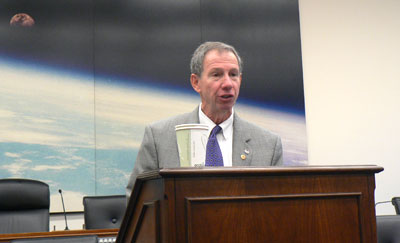The gospel according to Mikeby Taylor Dinerman
|
| Griffin managed to keep NASA’s various programs more or less on the rails at a time of hard choices and limited budgets. |
Two themes emerge from these speeches, and they both go to the heart of what a NASA administrator does. First of all he (and, perhaps someday soon, she) has to sell the space agency to the public and to Congress—these are the most important of what Mike Griffin calls the “stakeholders”. This is not an easy task and his January 2007 speech in Houston, where he lays out the difference between the “Real Reasons and the Acceptable Reasons”, is a profound meditation on why NASA is so important to the public’s view of what this country is all about and why it is so difficult sometimes to articulate that importance. Thus, he repeatedly quotes the words of former presidential science advisor John Marburger, who said that the ultimate goal of the exploration program is to “bring the solar system within humanity’s economic sphere.”
The second theme is the problems that faced him as the de facto head of the US civil space industry or community, as some prefer to call it. It is here that his frustration comes out, and it comes out in ways that may provide ammunition to his critics. As administrator he was charged with trying to ride herd on a large gaggle of exceptionally talented, energetic, and articulate individuals. This is a fundamentally impossible task, and most NASA administrators just ignore it.
Not Mike Griffin. At a critical moment in the history of the US space program, he saw just how dangerous the repeated formation of inward-looking circular firing squads had become and he tried to do something about it. One good example of this is the enduring feud between exploration and science. Speaking at the Goddard Space Flight Center in September 2006 he explained his view: “Exploration without science is not ‘tourism.’ It is far more than that. It is about the expansion of human activity beyond Earth. Exactly this point was made by Stephan Hawking, a pure scientist if there ever was one.”
| Mike Griffin was not an inspiring leader: no one at NASA would ever jump on the proverbial grenade for him. |
Responding to the critics of the Constellation architecture he said, “We at NASA cannot possibly make everyone happy with our decisions. Most decisions will produce an unhappy outcome for someone. However, that unhappiness is not by itself a symptom of incompetence, bad intentions or a lack of integrity on our part. Allocation of public funds to any particular alternative inevitably leaves aggrieved parties who believe with their own logic and passion, that their proposed alternative was the superior choice.” If the current NASA program is, as many expect, eviscerated, it will be interesting to hear what Griffin has to say about the choices his successor is forced to make.
Mike Griffin was not an inspiring leader: no one at NASA would ever jump on the proverbial grenade for him. Yet at a tough time he carried forward a program that, if properly funded, will take America and humanity back to the Moon and eventually beyond.
What may be the most interesting idea in the book involves the question of how NASA serves the national security interests of the United States. From its inception at the height of the Cold War the space agency has played an ambiguous and ill-defined role in creating and sustaining American power. A few years ago Neil Tyson suggested that the space program served the national security interest by inspiring and engaging large numbers of scientists who, if needed, could serve on a Manhattan Project of the future. Mike Griffin takes another tack: he believes that “if we must do hard things, it behooves us to also undertake activities which bind us to others in the world community. No activity has shown itself to be of greater inherent interest and excitement to others than has the exploration and development of the space frontier… what is the value of being a nation, a society, which leads the world in an endeavor that excites all others, one in which every nation that can do so seeks to partner with us?”
